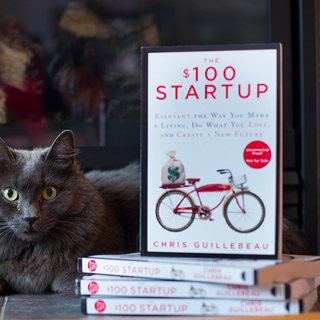Lessons from Illustrating The $100 Startup

I’m back on the road to meet readers of The $100 Startup!
After a summer break where I hosted WDS 2012 with a great team, traveled to Yemen and Congo, and began work on an upcoming business project, I’m glad to be hanging out with readers again and talking about freedom almost every night.
If you’ve read the book already, you might recognize the great illustrations that accompany the text. These were created by Mike Rohde, a Milwaukee-based artist.
Because so many people have enjoyed the illustrations, we thought we’d show you how the process unfolded. I asked Mike to share in his own words why he took on this project, and how he made the work.
Here’s Mike! –>
***
IN THE FALL of 2011, Chris Guillebeau reached out to me with a top secret project he was working on. It was his $100 Startup book and he needed illustrations to amplify the words he was writing in the book.
If not for my friend Jon Mueller at 800-CEO-READ, I might have declined the project, because at the time I was incredibly busy with multiple projects and was planning to write a book on sketchnoting.
I’d known a little about Chris, his blog and his book, AONC, but it was Jon who highly recommended Chris’s book project. So, I decided to go for it.

First, Chris and I had a call, where he shared his vision for the book and the illustrations he wanted to create. I’d come recommended by Crown, the same publisher behind my illustrations for 37signal’s book, REWORK, in 2010.
Once I had an early draft of Chris’s manuscript, I began thinking about ways to illustrate each chapter, which led to pencil sketching ideas for Chris to see.
Here are a few example chapter sketches:
***
Once sketches were completed, it was time to ink my illustrations and then convert the scans of my work into vectorized artwork. Vector artwork is different from the more common bitmapped art (pixel based) because the image is made up of mathematically placed points and curves to create images that are clean, crisp and infinitely resizable—either up or down.
Here are some sample vector art illustrations:
***
Chris and I worked through all 14 chapters of the book, making revisions and tweaks to the final artwork, right until the galley proofs went to press. Final tweaks were applied a short while later, in preparation for final print production.
Beyond the illustrations themselves, I’d like to share a few lessons learned from this project and ideas that have influenced me from chapters in Chris’ new book.
1. Listen to your advisors. I very nearly turned down the illustration project with Chris. Fortunately, I had Jon, a good friend who knows the book business and guided me as I pondered my decision.
I’ve learned over the years how critical it is to develop relationships with people in and out of my profession, so when I have an important decision to make, I can lean on their wisdom and objective opinions to help my thinking and decision making process.
If you don’t have advisors, start by inviting people you admire out to lunch or coffee, and getting to know them now, before you need their help. This will provide you with a network of friends happy to help you when the time comes to make decisions or bounce ideas around. Start now, before you need advisors!

2. Be aware of opportunities. One of the reasons I nearly declined Chris was my state of busyness when he contacted me about the book illustrations. I was still busy when I decided to take the project—so why did I decide to go ahead rather than decline?
Opportunity. After reviewing Chris’s work and getting a feel for his approach, attitude and personality, I felt the extra effort needed to get his illustrations done would be well-worth the sacrifice in the long-term.
I learned that Chris works hard to promote his work and the work of those with whom he partners. I also loved the topic of The $100 Startup, because it aligned so well with my own experience as a small business owner and because it feels like a practical guide to many of the ideas about business I’d already illustrated in REWORK.

In the middle of the crunch right around Thanksgiving last year, it was tough. I spent many hours getting the details right and finalizing every last bit of illustration work so Crown could produce galley proofs on time. Now, having gone through the pain, I’m happy I did, because I know this book will help many people start and build great businesses and I’m proud to have worked with Chris to amplify his message with fun, memorable images.
I believe there are opportunities all around, all of the time—if we have our eyes open to them. Thinking with an opportunity mindset is one of the greatest lessons The $100 Startup teaches. Try turning the problems you encounter around to see opportunities lurking in the background.
3. Think like an entrepreneur. My favorite part of Chris’s book are the stories of people who thought creatively about the services or products they could offer and found simple ways to make those creative ideas into small businesses.
My story about sketchnoting—the name I coined for my visual notes, captured with a pen in a small sketchbook at meetings and events—would fit well within the book. In 2007 I began sketchnoting events for myself, sharing the results online. In the past five years I’ve moved from doing sketchnotes for fun to being paid and often flown and housed by conferences to capture sketchnotes. I’m being hired to illustrate books, like The $100 Startup and REWORK, and am now writing my own book on sketchnoting techniques to teach other people how to take sketchnotes.
I started small, as a sole proprietorship. Eventually, opportunities to sketchnote and illustrate were expanding fast, so I created an LLC with my wife to get more serious about the business and reap the tax benefits of an LLC.
In many ways, I wish I had Chris’s book back in 2007 when I started on this path with my own business, though reading through the chapters for my illustration work reinforced many of the decisions I’ve made along the way and has given me many new ideas for the future.
I hope you throughly enjoy the hard work we poured into The $100 Startup, and that lessons I’ve learned through the process of illustrating the book will resonate and help you on your own journey.






The $100 Startup – Home Base
Buy on Amazon
Buy at BN
Buy from Your Local Bookstore
***
Back to Chris –>
I appreciate Mike sharing his lessons and experience here. After illustrating REWORK and The $100 Startup, he now has a book of his own coming out later this year, all about his process of sketchnoting. Read about it over here.
Oh, and be sure and follow him on Twitter!
Happy Monday, everyone. I’m flying to Minneapolis today, Chicago tomorrow, and Omaha on Wednesday.
– Chris
###













28 Comments
Thanks for the insight on both the creative and marketing process. I write and do woodturning but can’t sketch to save my life, so I’m always impressed by those who can.
All The Best
Thanks J. Delancy! I appreciate your kind words and am happy to share my process.
On sketching – I thing you really can sketch – you just need practice. In fact, that’s kinda what the Sketchnote Handbook I’m writing is all about. 🙂
I think you talked me into purchasing the book. Nice post.
Hey Mike,
Thanks for the great tips that you have so succinctly put together in this post.
My favourite – be aware of opportunities and take them even when you are busy or they push you out of your comfort zone. I’ve always done this in my life, but as a budding entrepreneur I sometimes find myself uncharacteristically more reticent to take risks and jump in the deep end.
Your example showed me its ok to take calculated risks, particularly if they feel like the right thing to do and something that will help you to grow.
Chris – Being a visual person, I love the illustrations in the book. It’s rare to see these types of illustrations in business books and I found they helped convey an idea in a way that words can’t always do.
Listen to your advisors is good advice – but also choose them carefully to start with!
This sketch noting thing sounds very intriguing! Pity I can’t draw!
Interested in knowing if you are coming to Ireland at any point Chris to meet readers/promote the book?
Niall
@Niall,
Nothing scheduled for Ireland yet, but hopefully at some point.
Great job Mike! Cave paintings and sketches were the first language humans understood. Your work helps people remember the lessons.
Continued success!
I always love hearing other artists’ process when it comes to working with clients. It’s good practice to always be thinking ahead, even though every opportunity you consider has a risk factor. I liked Mike’s point around looking at the potential of working with Chris, and seeing the long-term value of such a client relationship. Key for creatives. Thx for sharing.
Great post, love Mike’s perspective on “opportunities are everywhere.” I think our busyness often gets in the way of seeing those great opportunities too.
And to the folks who love sketchnotes but think they can’t draw….think again, yes you can.
You will be surprised….the more imperfect the drawing is, the more character it has.
@zen presence – excellent! Hope you really like the book.
@clare – thanks for the kind words. I’m pleased my illustrations successfully amplified Chris’ messages in the book.
@Hope – Agreed! Notice I said “invite those you admire” for lunch or coffee. 🙂
@niall – hoping my Sketchnote Handbook can help you give drawing another shot!
@paula – thank you! Great to hear the illustrations were helpful. Made my day!
Good advice and follow through. When an obstacle presents itself, find a way or advisor to help overcome or diminish the difficulties. I was interested in the target scene…I have thought some times a problem is like being in a dark room with a target on a wall that you can’t see. You have darts (choices) in your hands and must hit a bullseye (solution). Thanks Chris..enjoy your travels.
I hopped on over to Mike’s video and super- enjoyed the ceativity and innovation there. I am surely a candidate for his upcoming manual. Thank you Chris for sharing Mike’s person’s ideas and gift.
Chris thanks for sharing about the work with Mike on your book. I enjoyed reading this and Mike has a great point about mindset, being open to opportunities, and asking our friends and colleagues for input. Loved this back story. Thank you both!
Thank you Chris and Mike.
The drawings in the book really captured my attention and I found a few times adding to them a bit to apply it for me.
Great to see the lessons you learned.
K, bye
Thanks Mike and Chris! Reading The $100 Startup is helping me define key areas to place illustrations in my book, so this blog post is both timely and perfect. I love the concept of sketchnoting, and look forward to reading your book.
As a wannabe illustrator and children’s book author, I’m fascinated by this process! I’m bookmarking this for my own reference for how to deal with and present ideas to clients. I lament the book publishers don’t value hand-drawn art, which is my own specialty, and am reluctant to employ vector drawing because I feel I spend too much time at a computer as it is, while I can take my pen & ink with me in the car if I want to and draw at the library or in the park, wherever I want my office to be that day! But, I guess one has to change with the times. I really appreciate the insight, Mr. Rohde! And Chris, I’ve read the print version of $100 Start Up, and when I receive my new Kindle, it will be one of the first books I download to it!
Loved the illustrations in the book. Thanks for sharing your experience!
Thanks for a great post! I´m looking forward to the book, definitely going to buy it!
Hey Mike! I’m a huge fan of your work, great job! I just pre-ordered your book (with video) and I’m really looking forward to reading it. You made an awesome choice working with Chris, he’s an incredible guy and you’ve tapped into an amazing community. Thanks for being here with us! : )
Really awesome post.
The sketches throughout the book are awesome. It is amazing to me how something like this can be so easily overlooked yet is so powerful. It is forcing me to step back and think about ways to repurpose my own content.
The first lesson regarding listening to advisors really stuck with me. Sometimes, I become completely certain that I know exactly what I should do. But then I go and ask some of my trusted advisors and they will often throw out a question that I never thought about. It’s very powerful to have these type of people in our lives.
Very nice to have a look behind the scenes!
A great reminder why we need to take the best shots available to us, even if we’re busy.
Always awesome and inspiring to read about two smart people working together to create something amazing!
Wow, thanks everyone for your comments!
A few notes:
@niki – glad we could inspire you with your own book illustrations!
@iris – these pieces were all hand-drawn first, and brought into the computer later on. Vector work was done with a tool called VectorMagic, which maintains the hand-drawn feel. So, I think there is maybe a growing trend toward hand-drawn work. I hope you find that true as well!
@Travis, thanks for the kind words and the pre-order! I think Chris is a pretty awesome guy – I’m lucky to work with him.
@izzy – good to hear you’re digging he illustrations and the lesson I shared about advisors. It’s good to have alternative perspective from people you really admire and trust.
Great post! I’m a comic book artist and illustrator (specializing in comic biographies) and I just finished illustrating a book inspired in part by yours (it’s titled “Scale Up Your Internet Start Up”. I was just wondering, how do you decide on the rate? Does the artist dictate that or do you negotiate? I always have a problem figuring this out.
Jose – it really depends on the project. I think both parties need to be happy with the pricing in the end, so whether that is a fixed fee or hourly, really depends on you and your client.
Mike’s illustrations are awesome! I really enjoyed them in the book REWORK too. They really add to the writing. They just make me feel good, I can’t explain it.
Thanks for sharing!
John
Your comments are welcome! Please be nice and use your real name.
If you have a website, include it in the website field (not in the text of the comment).
Want to see your photo in the comments? Visit Gravatar.com to get one.